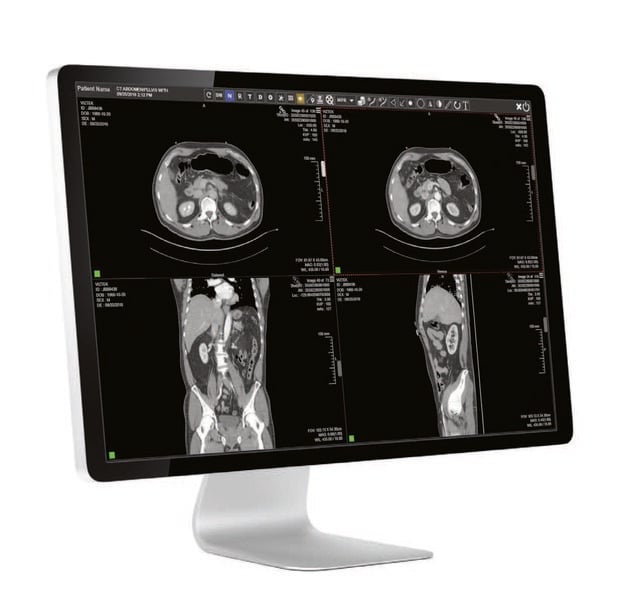
Image courtesy of Konica Minolta
Picture archiving and communication systems (PACS) play a crucial role in modern radiology by providing a digital platform for the storage, retrieval, distribution and presentation of medical images. A PACS acts as a computer network for digitized radiological images and reports. Recent trends in PACS have moved away from standalone systems to enterprise imaging systems that integrate not only radiology, but all departments that generate imaging and image related reports so they can be centralized in one location and integrated into the overarching electronic medical record (EMR).
Cloud-based PACS
Several PACS trends were showcased at RSNA23. Chief among them: cloud-based PACS. Many healthcare providers are moving toward cloud-based PACS solutions, allowing for easier access to medical images from different locations, facilitating collaboration among healthcare professionals, and reducing the need for on-premises infrastructure.
“The demand for the use of cloud in image management deployments is growing as healthcare providers look for more efficiencies in data management. Cloud-hosted, hybrid-cloud and cloud-adjacent solutions are now being offered by solution providers and the benefits include on-demand scalability and as-a-service cost models,” explained Michael Valante, global business development leader-healthcare, chief technology officer-digital pathology at Dell Technologies, in his ITN article titled “5 Major Trends Shaping the Future of Enterprise Imaging.” He added, “The implication of cloud over on-premise PACS deployments is they can more easily flex as their needs grow. Challenges exist, though, in the cost, security and performance expectations hospitals demand. In the end, it appears hybrid approaches will prevail as each delivers important values to this mission-critical solution.”
Visage. Visage Imaging showcased a series of new product additions and innovations, as well as its Visage 7 Enterprise Imaging Platform, engineered for CloudPACS, at RSNA23. The company also debuted its new research-based white paper, “Journey to the Cloud: Provider Considerations, Key Learnings and What’s Next,” based on interviews with experienced radiologists, IT professionals and C-suite executives representing institutions spanning academic, IDN and outpatient organizations, and authored by Signify Research’s research manager Amy Thompson. Visage 7 CloudPACS delivers sub-second image display based on industry standards and multi-cloud support, while propelling cloud adoption at a fraction of the storage cost of on-premise solutions.
Philips. In April 2023, Philips announced the availability of Philips HealthSuite Imaging on Amazon Web Services (AWS). The company stated that Philips and AWS will build on their relationship, advancing AI in healthcare by applying foundation models using Amazon Bedrock to accelerate the development of cloud-based generative AI applications that will provide clinical decision support, help enable more accurate diagnoses, and automate administrative tasks.
The availability of Philips HealthSuite Imaging on AWS is a new addition to Philips’ capabilities in enterprise informatics, and reportedly enables improved image access speeds, reliability, and data orchestration for radiologists and clinicians across the entire imaging workflow. These benefits allow healthcare organizations to reduce costs previously invested in on-premises hardware or data centers to host their image management platform — by managing growing workloads amidst staff shortages as well as speed time to diagnosis and treatment, enhancing patient outcomes.
Konica Minolta. Many healthcare organizations are turning to the public cloud to be more flexible, agile and scalable when deploying and managing their software, including Konica Minolta. It has adopted the software as a service (SaaS) model to offer its cloud-based Exa Platform and Symmetry PACS to healthcare organizations by collaborating with AWS and its medical imaging platform to host its Exa Platform and Symmetry PACS.
“Software as a service has been around for quite some time, and it is becoming more common in medical software, you pay for what you use,” said Kevin Borden, vice president of product, Konica Minolta Healthcare IT, in a recent interview with ITN. He added, “Konica Minolta has been in the private cloud for quite some time, and now the company is just taking it to the next level with the public cloud.”
According to Borden, Amazon has unique offerings to help vendors like Konica Minolta that make it easier to integrate their products into the cloud quicker, and in turn, pass those tools along to their customers. He explained that as an organization grows, the cloud has the infrastructure to grow the platform on-demand for each customer. Hardware, software and networks are continuously maintained and upgraded, reducing on-site hardware maintenance, IT staffing costs and the need for third-party IT vendors to manage the process.
Sectra. Last March, Sectra signed a ten-year renewal contract with Dutch medical center Zuyderland and will provide its enterprise imaging solution as a cloud service, Sectra One Cloud. This will provide Zuyderland with scalability as its imaging volumes grow in a secure and fully managed cloud environment. Since Sectra assumes responsibility for the technology and operation of the system, the healthcare provider can devote more time to its core business, offering the best possible patient care.
These above-mentioned innovations collectively contribute to the evolution of PACS, enhancing their capabilities, while improving patient care and streamlining radiology workflows.
View ITN's newly updated picture archiving and communication systems comparison chart


 December 17, 2025
December 17, 2025 









